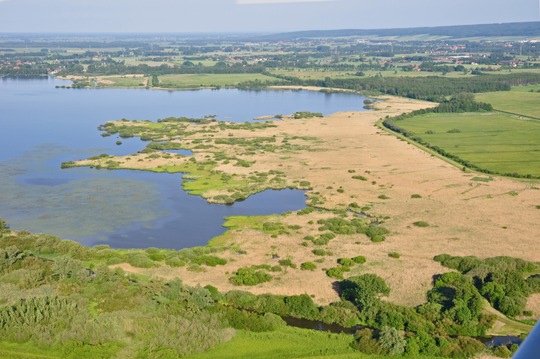After the Steinhuder Meer, the Dümmer is the second largest lake in the state of Lower Saxony with a water surface of about 1,300 hectares. The valuable ecosystem, which also includes adjacent wet grassland areas, extends over around 4,760 hectares. The lake, which was formed around 11,000 years ago during the last ice age, is on average only 1.10 meters deep and at no point deeper than 1.40 meters — and perhaps for this very reason is nevertheless a hotspot of biodiversity, especially for rare birds. It is one of Lower Saxony’s five wetlands of international importance protected under the RAMSAR Convention and is part of the European NATURA 2000 system of protected areas.
“The Dümmer exemplifies that nature forms fascinating networks. That is why our Living Lake of the Year award is for the lake, but also for its unique interconnectedness with other ecosystems, such as the extensive wetlands and wet meadows in its surroundings. This small-scale connectivity is the reason why a particularly large number of bird species — some of them extremely endangered — live in the area on and around the Dümmer, including garganey, spoonbill and bluethroat.”
- Bettina Schmidt, Project Manager
The wet grassland in turn attracts meadow birds such as snipe, black-tailed godwit, lapwing, redshank and the great curlew — even the very rare spotted crake is sometimes found. The pond rose fields on the lake provide a breeding ground for the largest colony of black terns in Lower Saxony. And ospreys and white-tailed eagles circle above the water and profit from the rich food supply in the lake.
Committed nature conservation: so that the lake will still be “alive” tomorrow
“We are proud to be able to take care of this species-rich wetland of Dümmer, which is so important for nature conservation,” says Frank Apffelstaedt from the Ecological Station Naturschutzring Dümmer e.V. “However, in doing so, we also take on a great responsibility for maintaining the current state of the ecosystem and, if possible, even improving it further. This not only involves a lot of work for many full-time staff and volunteers.
The key to success is the local network of nature conservation authorities from the state, the districts of Diepholz, Vechta and Osnabrück, the Naturschutzring Dümmer and other nature conservation associations, as well as the involvement of tourism, water sports and also agriculture. There are great challenges that we have to master together: In summer, many thousands of day tourists exert massive pressure of use on the Dümmer. From the catchment area of the Hunte as the main tributary of the Dümmer comes a too high nutrient input into the lake. Since the water level is kept high in summer, contrary to the natural course, the reeds in the shore area lack the opportunity to regenerate. And these are just some of the problems for which we have to keep finding solutions in exchange with local authorities, communities and local people.”
Measures taken are based on, among other things, extensive population surveys of waterfowl, wading birds and reedbed birds. Reed reeds are among the endangered habitats in many lake regions in Germany. For this reason, reedbeds on the lakeshore are specifically preserved and promoted. Based on the experience of several pilot projects, the Naturschutzring Dümmer e.V. relies here on a targeted combination of palisade and fence construction to reduce erosion caused by wave action on the one hand and to create calmed areas in front of the existing reeds on the other, where the reed plants can gradually spread again. Sand injection can be used to restore the eroded lake bottom.
Volunteers maintain the network of small bodies of water in the lake’s surroundings, allowing waterfowl, wading birds, amphibians, fish and rare plants to thrive. The Ecological Station Naturschutzring Dümmer e.V. also works to renaturalize raised bogs in the wider surroundings of the lake. Another focus of its activities is public relations and contact with visitors to the Dümmer area. Themed tours are offered on the lake, through the wetlands and into the raised bogs in the surrounding area. According to the environmentalists, it is crucial to enable sustainable nature experiences: those that are fun and take advantage of the high recreational value of the Dümmer habitat, but also impart the knowledge necessary to preserve the current “Living Lake of the Year”.
Passing on the important experiences from Dümmer to other lake regions in Germany is made possible by the support of the Living Lakes Network Germany by the Wilo Foundation. The foundation supports projects around the world relating to water as a resource, including initiatives of the Global Nature Fund. With the help of the Wilo Foundation, the network was also able to recruit the rowers of the German eight, multiple world and European champions, as ambassadors for Living Lakes Germany.

















